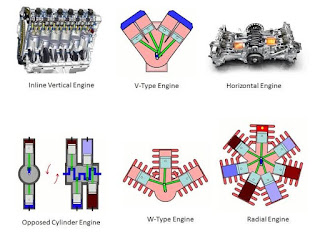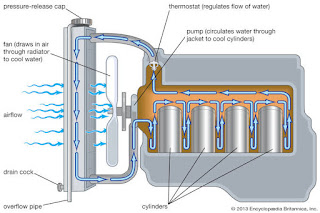Engine NSQF level 2-Unit 3
Engine
source:car and drive
Engine:- Engine is the heart of an automobile its role converts one form of energy in to another form.
Input energy→engine→useful another form of energy
one form of energy→engine→another form of energy
Engine is the heart of an automobile it's role converts chemical energy (fuel energy) in to mechanical energy.
or
"Engine is the heart of an automobile it's role converts chemical energy (fuel energy) in to mechanical work."
Input energy→engine→output energy
fuel(petrol/diesel/gas)→engine→vehicle movement
We can say again that the engine or motor is a machine designed to convert
energy into useful mechanical motion.
Heat engines, including internal combustion
engines and external combustion engines (such as steam engines) burn a fuel to create
heat, which, is then used to create motion.
for more details click below link👇
for video click above link👆
source:airplane advisor
Engine components
source:Pinterest
- Cylinder
- Piston
- Combustion Chamber
- Inlet Manifold
- Exhaust Manifold
- Inlet & Exhaust Valves
- Spark Plug
- Connecting Rod
- Crank Shaft
- Piston Rings
- Gudgeon Pin
- Cam Shaft
- Cams
- Flywheel
for more details click below link👇
for video click above link👆
Classification of Automobile Engines
The engines for the automotive use may be classified according to the following
considerations:
1. Based on Cycle of Operation.
• Otto Cycle Engine
• Diesel Cycle Engine
2.Based on No. of Strokes Per Cycle
• Two Stroke Engine-Two stroke engine are heat engines, they works with 2 strokes in one complete cycle, In a two-stroke engine, the end of the combustion stroke and the beginning of the compression stroke happen simultaneously, with the intake and exhaust (or scavenging) functions occurring at the same time.
• Four Stroke Engine:- Four stroke Engine are heat engine, they works with 4 strokes in one complete cycle. In which the piston completes four separate strokes while turning the crankshaft. A stroke refers to the full travel of the piston along the cylinder, in either direction.
3. Fuel Used
• Petrol Engine (or Gasoline Engine)- In this type of engine, petrol is used for as fuel.
• Diesel Engine:-In this type of engines, diesel is used as fuel.
• Gas Engine:- gas is used as fuel.
4. Types of Ignition:- engine is classified based on how the ignition take place.
• Spark Ignition (SI) Engine:-The charge(fuel+air) ignited by ⚡️ spark/ using spark plug,example-Petrol engine.
• Compression Ignition (CI) Engine:- The Charge(air) is ignited by compression high compression.example-Diesel engine.
5. No. of Cylinders:- Engines are divided on the basis of the engine consisting of how many cylinder.
• Single-cylinder Engine-The engine have 1 cylinder like bike engines.
• Two-cylinder Engine-The engine have 2 cylinders like bike -v engines.
• Three-cylinder Engine-The engine have 3 cylinder like car engines.
• Four-cylinder Engine-The engine have 4 cylinder like car 🚗 engines.
• Six-cylinder Engine-The engine have 6 cylinder like bus engines.
• Eight-cylinder Engine-The engine have 8 cylinders.
• Twelve-cylinder Engine- The engine have 12 cylinders.
• Sixteen-cylinder Engine-The engine have 16 cylinders.
6. Arrangement of Cylinders
• Inline Vertical Engine- cylinders are arranged in-line vertically.
• Horizontal Engine-The cylinders are arranged in horizontally in a engine.
• V-type Engine- The cylinders are arranged in V shape.
• Opposed cylinder Engine- The cylinders are arranged in opposite to each .
• Radial Engine-The cylinders are arranged in round, circular shape.
7. Valve Arrangement Engine:- Valve of the cylinders are arranged in following types,
• L-head Engine
• I-head Engine
• F-head Engine
• T-head Engine
8. Type of Cooling :- Which type of cooling is used for engine cooling
• Air-cooled Engine:-Air is used for cooling the engine , example-Two wheeler and three wheeler.
Source:-the engineer post
• Water-cooled Engine:-Water is used for removing the excess heat from engine. example car engine, bus engine etc.
9. Speed:-Based on the speed of the engine
• Low Speed Engine- slow speed engines
• High Speed Engine- more speed engines
• Medium Speed Engine-normal speed engines.
10. Method of Fuel Injection
• Carburetor Engine
• Air Injection Engine
• Airless or Solid Injection Engine
11. Method of Governing
• Hit and miss governed Engine
• Qualitatively governed Engine
• Quantitatively governed Engine
12. Application:- Where engine can used I.e. application of engine.
• Stationary Engine:- Normally used in labs or fixed engines .
• Automotive Engine:- Automobile engines are used in moving the vehicle by roads.
• Locomotive Engine:- Locomotive engines are used to move locomotive by rail.
• Marine Engine:- Marine engines are used to move the vehicle on water.
• Aircraft Engine:-Aircraft engines are used to move the aircraft by air.
• Wankel Engine:- Wankel engine is a type of rotary engine.
• Automotive Gas Turbine:-It is a turbine to rotating the turbine and produces the energy that energy is used to move the vehicle.
- Top Dead Center (T.D.C): "It is the top most position of the piston towards cylinder head".
• Bottom Dead Center (B.D.C): "It is the lowest position of the piston farthest from the cylinder head.
• Bore: Diameter of the engine cylinder is called bore.
• Stroke: Distance traveled by the piston in moving from T.D.C. to the B.D.C is called ‘stroke’.
• Clearance Volume: The volume of cylinder above the piston when it is in the T.D.C. position is referred to as ‘clearance volume’ (Vc).
• Piston Displacement: This is the volume swept by the piston in moving from T.D.C. to B.D.C. This is also called ‘swept volume’.
If ‘d’ is the cylinder bore
‘S’ the stroke,
'Vs' the piston displacement,
• Engine Capacity: This is the total piston displacement or the Swept volume of all the cylinders.
If ‘n’ is the number of cylinders and Vs is the piston displacement, then ‘engine displacement’ or engine capacity Vd, is given by,
Vd = Vs.n
• Compression Ratio: This indicates the extent to which the charge in the engine is compressed.
This is calculated as the ratio of the volume above the piston at B.D.C. to the volume above the piston at T.D.C.
If ‘y’ is the compression ratio, then
For petrol engines, compression ratios are about 8 to 9.5 : 1,
whereas for diesel engines, these vary from 16 to 22.
• Power: It is the work done in a given period of time.
• Horse Power (H.P.): This is the amount of energy required to do 4500kgm. of work in one minute.
• Indicated Horse Power (I.H.P): The power developed within the engine cylinders is called indicated horse power. This is calculated from the area of the engine indicator diagram.
• Brake Horse Power (B.H.P): This is the actual power delivered at the crankshaft. It is obtained by deducting various power losses in the engine from the indicated horse power.
• Friction Horse Power (F.H.P.): This is the power lost due to friction present between different matching components.
FHP=IHP-BHP
Engine Torque: It is the force of rotation acting about the crankshaft axis at any given instant of time. It is expressed in newton-metre (Nm).
source:-ExtruDesign
Questions and answers (common questions asked in examination)
I.MCQ
1. ............is the engine ,the combination take place outside the engine
a. Petrol engine b. Diesel engine
c. Steam engine d. None of the above
2. It is the example for External combustion engine is____________
a. Steam engine b. petrol engine c. disel engine d.gas engine
3. The component used to ignite the fuel in petrol engine is______________
a. Spark Plug b. Push rod c. Radiator d.Carburettor
4. One horse-power is equal to
a. 9000 kg.m b. 5000 kg.m c.6000 kg.m d. 4500 kg.m
5. Frictional horse power is equal to
a. F.H.P = I.H.P – B.H.P b. F.H.P = B.H.P – I.H.P
c. F.H.P = B.H.P / I.H.P d. F.H.P = I.H.P / B.H.P
II. Answer the following
1. What is a heat engine ?
Ans:- Engine is the heart of an automobile it's role converts chemical energy (fuel energy) in to mechanical energy.
2. Name the types of automobile engines based on the cycles of operation.
Ans:- Engine is the heart of an automobile it's role converts chemical energy (fuel energy) in to mechanical energy.
2. Name the types of automobile engines based on the cycles of operation.
Ans:- 1.Otto cycle
2. diesel engine
3. Classify the automobile engine based on number of cylinders
3. Classify the automobile engine based on number of cylinders
Ans:- 1. Single cylinder engine
2. two cylinder engine
3. Three cylinder engine
4. Four cylinder engine
5. Six cylinder engine
6. Eight cylinder engine
7. Twelve-cylinder engine
8. Sixteen-cylinder Engine
4. Expand the following related to automobile engine : a) T.D.C. b) B.D.C. c) B.H.P. d) I.H.P. Ans:- a) T.D.C:- Top dead center.
b) B.D.C. :- Bottom dead center
c) B.H.P. :- Break horse power
d) I.H.P :- Indicated horse power
5. Explain the following technical terms : a) Piston displacement b) Engine capacity.
5. Explain the following technical terms : a) Piston displacement b) Engine capacity.
Ans:-a) Piston displacement:-This is the volume swept by the piston in moving from T.D.C. to B.D.C. This is also called ‘swept volume’.
b) Engine capacity:-This is the total piston displacement or the Swept volume of all the cylinders.
If ‘n’ is the number of cylinders and Vs is the piston displacement, then ‘engine displacement’ or engine capacity Vd, is given by,
Vd = Vs.n
6. What is compression ratio ?Ans:-This indicates the extent to which the charge in the engine is compressed.
This is calculated as the ratio of the volume above the piston at B.D.C. to the volume above the piston at T.D.C.
If ‘y’ is the compression ratio, then
7. Define friction horse power
Ans:-This is the power lost due to friction present between different matching components.
FHP=IHP-BHP
8. List the various components of engine? Note down the different components/ parts of engine?- Cylinder
- Piston
- Combustion Chamber
- Inlet Manifold
- Exhaust Manifold
- Inlet & Exhaust Valves
- Spark Plug
- Connecting Rod
- Crank Shaft
- Piston Rings
- Gudgeon Pin
- Cam Shaft
- Cams
- Flywheel
Draw a neat diagram of the following
1.Engine / SI engine /Heat engine / Petrol engine
2. CI engine/ diesel engine
source:airplane advisor
3. Wankel wheel / rotary engine
Source: Car bike Tech
4.Technical terms/ Terminology of Engine
source:-ExtruDesign

































Comments
Post a Comment